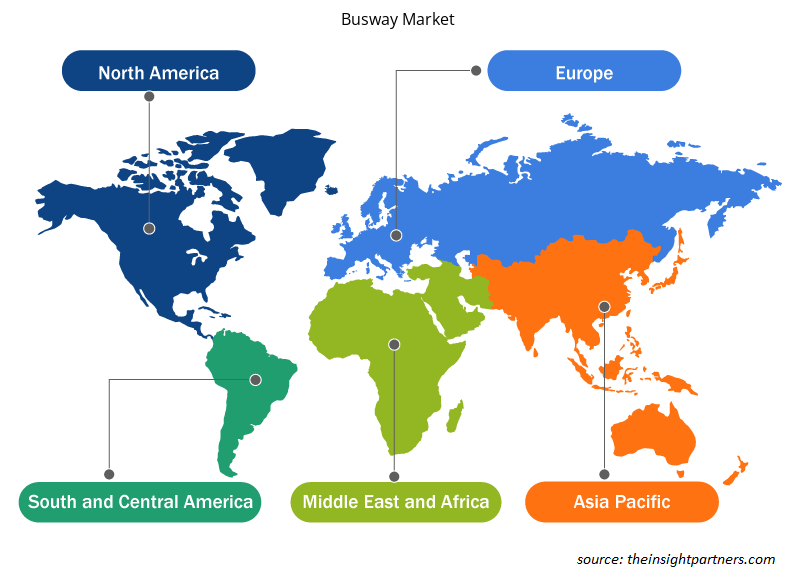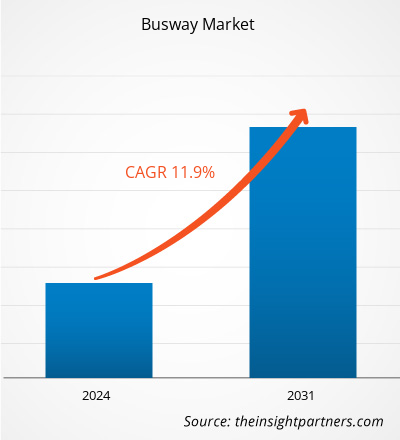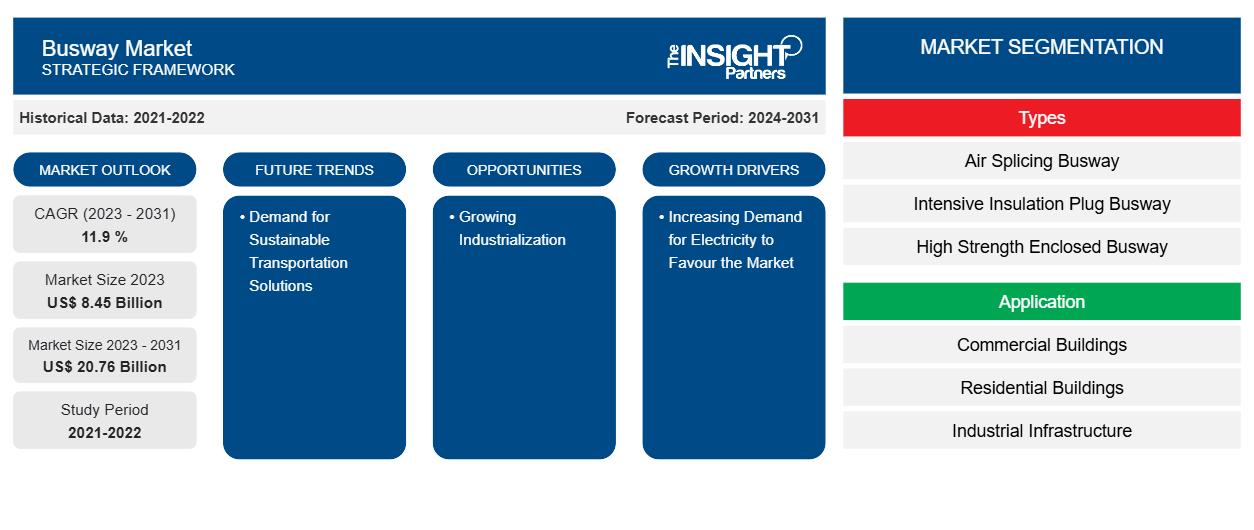Si prevede che la dimensione del mercato delle corsie preferenziali per autobus raggiungerà i 20,76 miliardi di dollari entro il 2031, rispetto agli 8,45 miliardi di dollari del 2023. Si prevede che il mercato registrerà un CAGR dell'11,9% nel 2023-2031. La crescente domanda di elettricità e la crescente industrializzazione rimarranno probabilmente le tendenze chiave del mercato delle corsie preferenziali per autobus.
Analisi di mercato Busway
Si osservano diverse tendenze di crescita in diverse regioni di questo settore. I mercati sviluppati del Nord America (NA) e dell'Europa (ELI) rappresentano una parte significativa della quota di mercato globale; tuttavia, i paesi in via di sviluppo in regioni come Asia Pacifico (APAC), Medio Oriente e Africa (ME), Africa e Sud America (SAM) stanno crescendo rapidamente a causa di una serie di fattori come la necessità di elettrificazione e la crescita di nuove industrie e infrastrutture. Si prevede che l'adozione di Busway aumenterà rapidamente nei prossimi anni a causa dell'espansione delle reti elettriche e dello sviluppo di impianti di energia rinnovabile a livello globale.
Panoramica del mercato Busway
La National Electrical Manufacturers Association (NEMA) definisce una blindo sbarre come un sistema di distribuzione elettrica prefabbricato costituito da tratti rettilinei, raccordi, dispositivi e accessori, tutti racchiusi in un involucro protettivo. Le blindo sbarre trasportano l'energia e la collegano ad apparecchiature elettriche come trasformatori, quadri elettrici e quadri di commutazione . Nelle applicazioni commerciali e industriali, una blindo sbarre è un ottimo sostituto di cavi e condotti perché è più facile da sostituire, meno costosa da installare e richiede meno lavoro di configurazione, specialmente in scenari in cui è probabile che le posizioni del carico varino.
Personalizza questo report in base alle tue esigenze
Riceverai la personalizzazione gratuita di qualsiasi report, comprese parti di questo report, o analisi a livello nazionale, pacchetto dati Excel, oltre a usufruire di grandi offerte e sconti per start-up e università
-
Scopri le principali tendenze di mercato in questo rapporto.Questo campione GRATUITO includerà analisi di dati che spaziano dalle tendenze di mercato alle stime e alle previsioni.
Driver e opportunità del mercato delle corsie preferenziali
Aumento della domanda di energia elettrica per favorire il mercato.
L'uso dell'elettricità è aumentato negli ultimi decenni ed è ora essenziale per le economie moderne. A causa dell'aumento del reddito disponibile, si prevede che questa domanda aumenterà nei prossimi anni. L'aumento del consumo di elettricità ha portato a un aumento dell'uso di elettricità nelle industrie degli utenti finali e nelle automobili. Esistono due diversi modelli geografici per la domanda di elettricità. I guadagni di efficienza energetica controbilanciano la crescita futura associata all'aumento dell'elettrificazione e della digitalizzazione nelle economie avanzate.
Crescente industrializzazione
La crescente industrializzazione porta allo sviluppo di nuove fabbriche e impianti di produzione, che necessitano di una solida infrastruttura elettrica per alimentare macchinari e attrezzature, creando una domanda di sistemi di autobus per distribuire l'elettricità in modo efficiente.busway systems to efficiently distribute electricity.
Analisi della segmentazione del rapporto di mercato Busway Market Report Segmentation Analysis
I segmenti chiave che hanno contribuito alla derivazione dell'analisi di mercato delle corsie preferenziali sono tipologie e applicazioni.busway market analysis are types and applications.
- In base alla tipologia, il mercato delle blindo blindate è suddiviso in blindo blindate con giunzione ad aria (BMC), blindo blindate con tappi di isolamento intensivo (CMC), blindo blindate chiuse ad alta resistenza (CFW) e altri.busway market is divided into air splicing busways (BMC), intensive insulation plugs busways (CMC), high-strength enclosed busways (CFW), and others).
- In base all'applicazione, il mercato è segmentato in edifici commerciali, edifici residenziali, infrastrutture industriali e altri.
Analisi della quota di mercato delle corsie preferenziali per area geografica Market Share Analysis by Geography
L'ambito geografico del rapporto sul mercato delle corsie preferenziali è suddiviso principalmente in cinque regioni: Nord America, Asia Pacifico, Europa, Medio Oriente e Africa e Sud America/Sud e Centro America. Il Nord America ha dominato il mercato delle corsie preferenziali. Le tendenze di adozione di tecnologie elevate in vari settori nella regione nordamericana hanno alimentato la crescita del mercato delle corsie preferenziali. Inoltre, una forte enfasi sulla ricerca e sviluppo nelle economie sviluppate degli Stati Uniti e del Canada sta costringendo gli operatori nordamericani a portare sul mercato soluzioni tecnologicamente avanzate. Inoltre, gli Stati Uniti hanno molti operatori del mercato delle corsie preferenziali che si sono sempre più concentrati sullo sviluppo di soluzioni innovative. Tutti questi fattori contribuiscono alla crescita del mercato delle corsie preferenziali nella regione.busway market report is mainly divided into five regions: North America, Asia Pacific, Europe, Middle East & Africa, and South America/South & Central America. North America has dominated the busway market. High technology adoption trends in various industries in the North American region have fuelled the growth of the busway market. Moreover, a strong emphasis on research and development in the developed economies of the US and Canada is forcing the North American players to bring technologically advanced solutions into the market. In addition, the US has many busway market players who have been increasingly focusing on developing innovative solutions. All these factors contribute to the region's growth of the busway market.
Approfondimenti regionali sul mercato Busway
Le tendenze regionali e i fattori che influenzano il Busway Market durante il periodo di previsione sono stati ampiamente spiegati dagli analisti di Insight Partners. Questa sezione discute anche i segmenti e la geografia del Busway Market in Nord America, Europa, Asia Pacifico, Medio Oriente e Africa, e Sud e Centro America.

- Ottieni i dati specifici regionali per il mercato Busway
Ambito del rapporto di mercato Busway
| Attributo del report | Dettagli |
|---|---|
| Dimensioni del mercato nel 2023 | 8,45 miliardi di dollari USA |
| Dimensioni del mercato entro il 2031 | 20,76 miliardi di dollari USA |
| CAGR globale (2023-2031) | 11,9% |
| Dati storici | 2021-2022 |
| Periodo di previsione | 2024-2031 |
| Segmenti coperti |
Per tipi
|
| Regioni e Paesi coperti |
America del Nord
|
| Leader di mercato e profili aziendali chiave |
|
Densità degli attori del mercato Busway: comprendere il suo impatto sulle dinamiche aziendali
Il mercato Busway Market sta crescendo rapidamente, spinto dalla crescente domanda degli utenti finali dovuta a fattori quali l'evoluzione delle preferenze dei consumatori, i progressi tecnologici e una maggiore consapevolezza dei vantaggi del prodotto. Con l'aumento della domanda, le aziende stanno ampliando le loro offerte, innovando per soddisfare le esigenze dei consumatori e capitalizzando sulle tendenze emergenti, il che alimenta ulteriormente la crescita del mercato.
La densità degli operatori di mercato si riferisce alla distribuzione di aziende o società che operano in un particolare mercato o settore. Indica quanti concorrenti (operatori di mercato) sono presenti in un dato spazio di mercato in relazione alle sue dimensioni o al valore di mercato totale.
Le principali aziende che operano nel mercato Busway sono:
- Schneider elettrico
- Siemens
- Mangiare
- Cavi e sistemi LS
- Spina di alimentazione Busduct Sdn. Bhd.
- ABB
Disclaimer : le aziende elencate sopra non sono classificate secondo un ordine particolare.

- Ottieni una panoramica dei principali attori del mercato Busway
Notizie e sviluppi recenti sul mercato Busway
Il mercato delle corsie riservate agli autobus viene valutato raccogliendo dati qualitativi e quantitativi dopo la ricerca primaria e secondaria, che include importanti pubblicazioni aziendali, dati associativi e database. Di seguito è riportato un elenco degli sviluppi nel mercato:
- Nel giugno 2021, la società di gestione energetica Eaton ha annunciato di aver completato l'acquisizione di una quota del 50 percento nell'attività Busway di Jiangsu YiNeng Electric, che produce e commercializza prodotti Busway in Cina e ha registrato vendite per 60 milioni di dollari nel 2020.
(Fonte: Eaton, Comunicato stampa, 2021)
Copertura e risultati del rapporto sul mercato Busway
Il rapporto "Busway Market Size and Forecast (2021–2031)" fornisce un'analisi dettagliata del mercato che copre le seguenti aree:
- Dimensioni e previsioni del mercato a livello globale, regionale e nazionale per tutti i segmenti di mercato chiave coperti dall'ambito
- Dinamiche di mercato come fattori trainanti, vincoli e opportunità chiave
- Principali tendenze future
- Analisi dettagliata delle cinque forze PEST/Porter e SWOT
- Analisi di mercato globale e regionale che copre le principali tendenze di mercato, i principali attori, le normative e gli sviluppi recenti del mercato
- Analisi del panorama industriale e della concorrenza che copre la concentrazione del mercato, l'analisi della mappa di calore, i principali attori e gli sviluppi recenti
- Profili aziendali dettagliati
- Analisi storica (2 anni), anno base, previsione (7 anni) con CAGR
- Analisi PEST e SWOT
- Valore/volume delle dimensioni del mercato - Globale, Regionale, Nazionale
- Industria e panorama competitivo
- Set di dati Excel
Report recenti
Testimonianze
Motivo dell'acquisto
- Processo decisionale informato
- Comprensione delle dinamiche di mercato
- Analisi competitiva
- Analisi dei clienti
- Previsioni di mercato
- Mitigazione del rischio
- Pianificazione strategica
- Giustificazione degli investimenti
- Identificazione dei mercati emergenti
- Miglioramento delle strategie di marketing
- Aumento dell'efficienza operativa
- Allineamento alle tendenze normative























 Ottieni un campione gratuito per - Mercato Busway
Ottieni un campione gratuito per - Mercato Busway